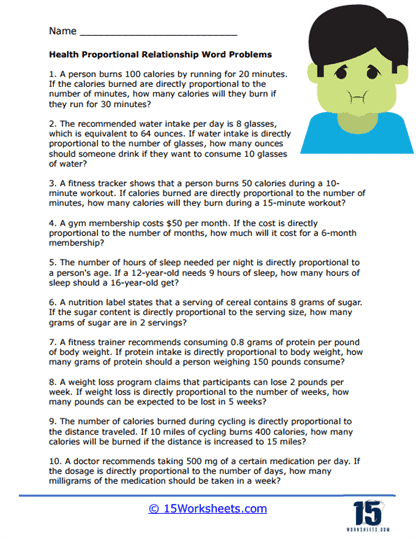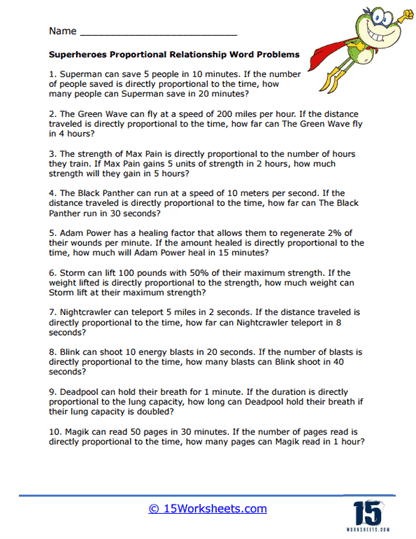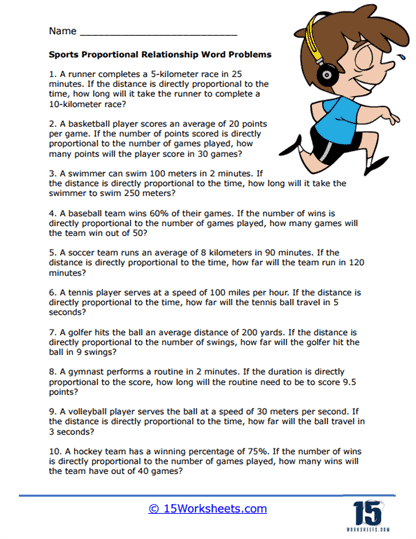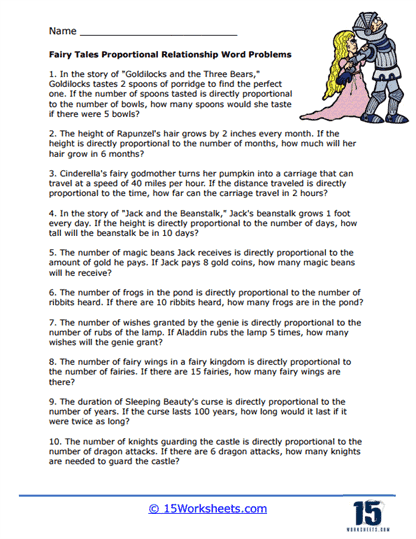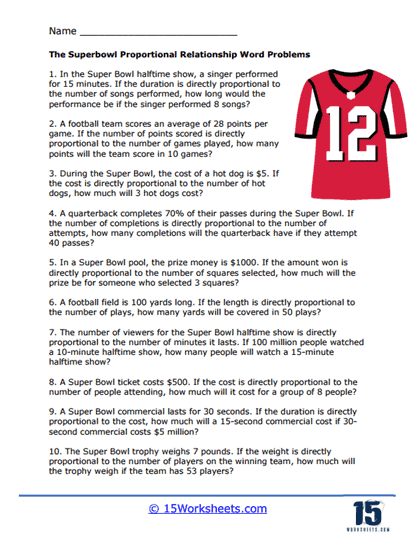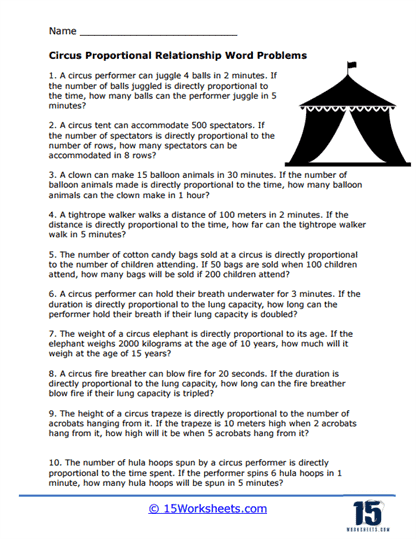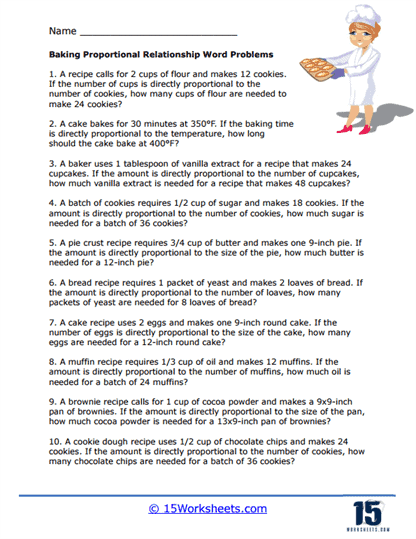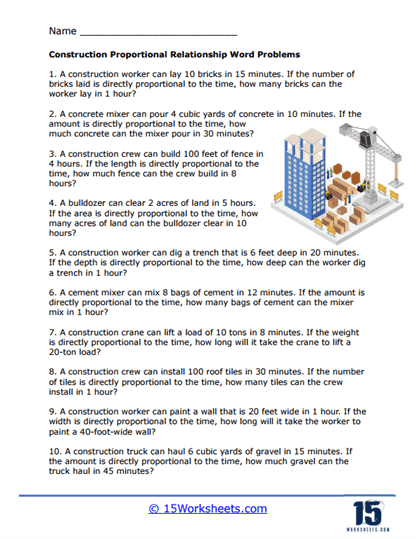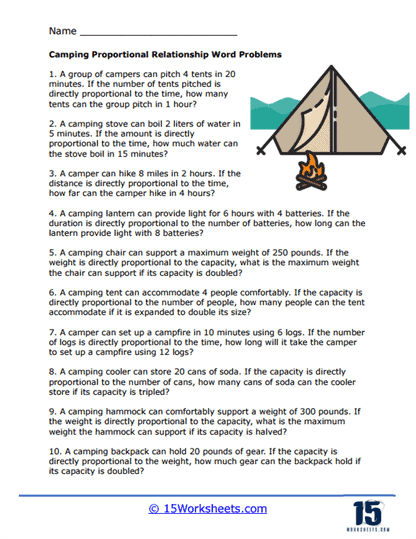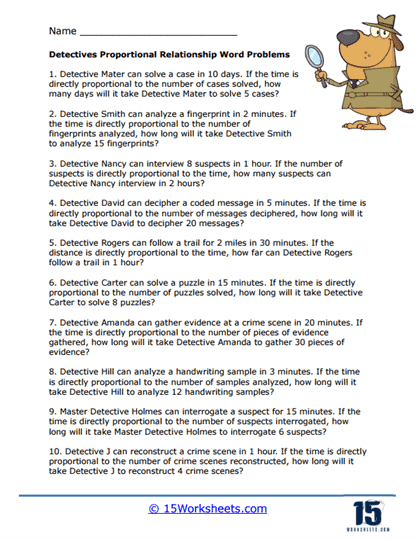Proportional Relationship Word Problems Worksheets
About These 15 Worksheets
These worksheets were designed to help students understand and apply the concept of proportionality in real-world scenarios. These worksheets present situations where two quantities are related in such a way that they maintain a constant ratio, which is a key characteristic of proportional relationships. Proportional relationships are fundamental in mathematics and are often used to solve various types of problems involving ratios and proportions.
Proportional relationship word problem worksheets cover a wide range of topics and complexity levels, making them suitable for different grade levels and skill levels. They can involve tasks such as finding the constant of proportionality, determining equivalent ratios, scaling up or down quantities while maintaining proportionality, and solving real-life situations that require proportional thinking. These problems encourage students to interpret written information, identify the relationship between quantities, and use proportional reasoning to find solutions.
By working through proportional relationship word problem worksheets, students develop essential mathematical skills, including the ability to recognize and analyze proportional relationships, make predictions based on proportions, and apply proportionality to solve problems in various contexts.
Examples of Proportional Word Problems
Problem 1 (Easy): A car travels 240 miles in 4 hours at a constant speed. How far will the car travel in 7 hours at the same speed?
Solution: To solve this problem, you can use the concept of proportionality. The car’s speed is constant, so the distance it travels is directly proportional to the time it travels. You can set up a proportion:
Distance 1 / Time 1 = Distance 2 / Time 2
Where Distance 1 is 240 miles, Time 1 is 4 hours, and Time 2 is 7 hours (the time we want to find). We can solve for Distance 2:
240 / 4 = Distance 2 / 7
Now, cross-multiply and solve for Distance 2: 4 x Distance 2 = 240 * 7
4 x Distance 2 = 1680
Now, divide both sides by 4:
Distance 2 = 1680 / 4
Distance 2 = 420 miles
So, the car will travel 420 miles in 7 hours at the same speed.
Problem 2 (Intermediate): A factory produces 300 widgets in 5 hours. If the factory continues to produce widgets at the same rate, how many widgets will it produce in 8 hours?
Solution: To solve this problem, we can again use the concept of proportionality. The factory’s production rate is constant, so the number of widgets produced is directly proportional to the time it takes. We can set up a proportion:
Widgets 1 / Time 1 = Widgets 2 / Time 2
Where Widgets 1 is 300 widgets, Time 1 is 5 hours, and Time 2 is 8 hours (the time we want to find). We can solve for Widgets 2:
300 / 5 = Widgets 2 / 8
Now, cross-multiply and solve for Widgets 2: 5 x Widgets 2 = 300 x 8
5 x Widgets 2 = 2400
Now, divide both sides by 5:
Widgets 2 = 2400 / 5
Widgets 2 = 480 widgets
So, the factory will produce 480 widgets in 8 hours at the same rate.
What Are Proportional Relationships?
A proportional relationship is a concept in mathematics that describes a relationship between two quantities where the ratio of one quantity to the other is constant. This means that for every unit increase in one quantity, there is a corresponding constant increase in the other.
To give a simple example, if you have a proportional relationship between the number of cars and the amount of gasoline consumed, then for every car that you add (assuming each car consumes the same amount of gas), the amount of gasoline consumed will increase by the same amount. If one car consumes 10 gallons of gas, then two cars would consume 20 gallons, three cars would consume 30 gallons, and so on. The ratio of cars to gasoline consumption (in gallons) is always the same.
Proportional relationships matter for several reasons:
Understanding Proportions in Daily Life – Many real-world scenarios involve proportions. For instance, if you are following a recipe and need to adjust it to serve more people, you need to understand proportions to increase the ingredients appropriately.
Predictive Power – Proportional relationships can be used to predict outcomes. For example, if you know the speed at which you are traveling and the distance you need to go, you can calculate the time it will take to get there.
Business and Economics – In business and economics, understanding proportions is crucial. It’s often used in understanding ratios and rates, like cost-benefit analyses, return on investment, or price-to-earnings ratios.
Sciences – Many scientific formulas are based on proportional relationships, like the ideal gas law in physics or the rate equations in chemistry.
Mathematical Literacy – Proportional reasoning is an important part of mathematical literacy. It forms the basis for more complex math topics, such as algebra and calculus.
Understanding proportions allows us to make sense of patterns and relationships, and it enables us to make predictions about the world around us. It’s a foundational concept in mathematics that has wide-ranging applications.
How to Solve Proportional Relationship Word Problems
Proportional relationship word problems involve scenarios where two things are compared, and that comparison remains constant. Here are steps to solve these problems:
Identify the two quantities that are being compared. This will typically be fairly obvious from the problem. For example, the problem might be comparing the number of hours worked to the amount of money earned.
Identify the constant of proportionality (also known as the rate or unit rate). This is the ratio of one quantity to the other, and it should remain constant throughout the problem.
Set up a proportion. A proportion is an equation that states that two ratios are equal. If you know the rate (the constant of proportionality) and one of the quantities, you can set up a proportion to solve for the other quantity.
Solve the proportion. You can solve the proportion by cross-multiplying and then solving for the unknown.
Let’s illustrate this with an example:
Problem – Steve earns $15 per hour for mowing lawns. How much will he earn for 7 hours of work?
Identify the two quantities being compared – Here, the two quantities are hours worked and money earned.
Identify the constant of proportionality (rate) – The problem tells us that Steve earns $15 per hour, so the rate is $15/hour.
Set up a proportion – We can set this up as an equation. We know the rate is $15/hour, and we want to know how much he earns for 7 hours. So we have:
15 (dollars/hour) = x (dollars) / 7 (hours)
Solve the proportion – Now we solve for x:
Cross multiply – 15 x 7 = x
Therefore, x = $105
So, Steve will earn $105 for 7 hours of work.
When We Would Use This Skill
Proportional relationships are everywhere in our daily lives, and understanding them can be incredibly useful. Here are some real-world situations where you might need to solve proportional relationship word problems:
Cooking and Baking – Recipes are based on proportional relationships. If you have a recipe for 4 people but you want to serve 8, you’ll need to scale up the quantity of each ingredient proportionally.
Travel – If you know the speed at which you’re traveling and you need to calculate how long it will take to reach your destination, you’ll be using a proportional relationship.
Financial Planning – Proportions are useful for understanding interest, calculating tax, or figuring out how much you need to save each month to reach a financial goal.
Home Improvement – If you’re painting a room and you know how much area a can of paint will cover, you can calculate how many cans you’ll need based on the size of your room.
Shopping – If you’re comparing prices, especially prices per unit (like price per ounce), you’re using proportional relationships.
Fitness – If you’re counting calories and you know how many calories are in one serving of a food, you can calculate how many calories there are in multiple servings.
Environment – Calculating carbon footprint based on amount of certain activities, understanding energy consumption and production, etc., all require understanding of proportions.
Work – If you’re paid by the hour and you want to know how much you’ll earn in a certain number of hours, you’re dealing with a proportional relationship.



